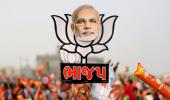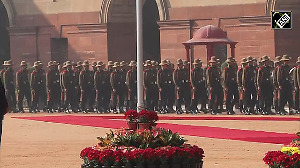'So far the youth were Modi's strength.'
'It now seems under pressure, and for good reason: Crisis in education, jobs, slowdown in manufacturing, and thereby trading,' points out Shekhar Gupta.

IMAGE: Prime Minister Narendra A Modi and BJP President Amit A Shah at the party's parliamentary board meeting in New Delhi after the Gujarat election results. Photograph: Kamal Kishore/PTI Photo
'Writings on the Wall' is a metaphor we have used for almost two decades now as we travel around the country -- and sometimes in the neighbourhood -- mostly, but not necessarily during elections.
Writings on the Wall, because invariably, if you read what is written there carefully, with the ears, nose and mind open, you can read what is on people's minds -- what is changing and what isn't and why.
Often, though not always, these tell you who people want to vote for, or against.
The last time we walked through poll-bound Gujarat in 2012, we noted that the 'walls' you needed to read in Narendra Modi's Gujarat were not the conventional ones as elsewhere, where you read graffiti or advertisements.
In Gujarat, we noted in 2012, the walls had a different meaning. They were the endless series of blank grey or white lines of factories flanking the highways.
These were the canals brimming with water. And, if you looked down from an airplane and the land was dotted with small water bodies and check-dams, you knew you were over Gujarat.
The invincibility of Modi was written on these 'walls'.
The important thing about Gujarat under Modi was the absence of evident economic or employment stress, resentment over the riches of the 'other', and pessimism.
This has changed now. For sure, there is no desperation or pessimism of the kind we saw in Uttar Pradesh, especially in its east during the last elections, but there is unhappiness, and the young don' hide it.
In villages, you see a sight more familiar in West Bengal -- unemployed young men hanging around in clumps, smoking, watching their phones, playing cards, and generally whiling away time.
They aren't poor as in West Bengal -- they often have motorcycles. But they are jobless, and many have had temporary jobs before.
In Charal village, in the heart of the Tata Nano zone, two such clumps have young people mockingly mimicking Modi's speeches and cursing their jobless fate. Of course, these are mostly Patidars so a special sense of anger is expected, but this isn't your usual, familiar scene in Gujarat.
If you want to know where it is coming from, see Ahmedabad's walls.
Along any wide avenue, these are painted -- wall-to-wall -- with advertisements of the kind we are familiar with in Punjab and increasingly in other parts of the country, selling easy admission to low-quality educational institutions overseas.
Some were seen in Gujarat in the past too, but never in these numbers. Now, not just the walls, but the smaller hoardings, street-pole kiosks and unipoles are all filled with the same wares.
America, England, Canada, and Australia we know from the many well-developed but now tired regions, notably Punjab.
These are new to Gujarat in these numbers. Joining these destinations now is also a relative newcomer: Poland. Now Poland is no educational destination but when you are desperate to get out, any place will do.
This speaks for three things: An undersupply of higher education, poor, unemployable quality of what is on offer, and joblessness.
Much of the immigration from Punjab is now desperate, more in the nature of seeking economic refuge.
From Gujarat, it used to be for business and enterprise. The current wave seems driven by economic compulsion and joblessness.
In a still part-finished apartment building we find the 24 year old who is using this desperation to fuel his own unique politics.
Hardik Patel has risen from nowhere to be the second-most popular leader of the Gujarati street -- albeit of one caste, the Patidars or Patels. Tens of thousands of young Patels follow his call, never mind tear gas and bullets.
Following his processions or road shows brings back to me the popularity of the Assam students agitation leaders of the early 1980s.
His followers are driven by blind loyalty. His is a cult. Hardik's core demand is OBC status and thereby job reservation for his community.
At his road shows you'd also hear language for Modi not even his toughest political rivals use, least of all in Gujarat.
I was struck by: 'Dekho, dekho kaun aaya, Modi tera baap aaya (See who's come, Modi, it's your dad).' It's nutty for a 24 year old.
He hasn't risen from student politics though he enrolled for a BCom course in a local college.
He is the product of a kind of the Patel khap movement. He got involved with his community]s campaign 'to save our bahu-betis from being taken away by other communities', he says.
His basic impulse is deeply casteist, socially conservative, and rabble-rousing. He has clarity in his mind.
"You want to know why I am popular. My grandparents had a hundred bighas of land, I have two. What happened to the rest? We've been selling land and surviving. Every Patel family faces that plight," he says.
In Gujarat, he says, nobody can get married unless he has a job or a decent business. Neither is available now, so boys can't even get married.
He may be new to demagoguery, but speaks with assurance which makes you either marvel at his precocious genius or want to check out his birth certificate.
Is more than 50 per cent reservation even possible? How does it matter, he asks. Some special dispensation can be found.
Right now, his only objective is to help defeat Modi whose government externed him from the state, put him under house arrest in Udaipur, Rajasthan, killed around 15 Patidars in police firing, and leaked intimate sexual recordings said to be of him with an unidentified woman.
He loves to be reminded that he is too young to contest but insists he isn't interested in any office. I notice in the room Balasaheb Thackeray's framed portrait and his own pictures with Uddhav and Aaditya, who, he says, is 'brilliant'. Why Balasaheb? Do you idolise him?
You see, the man never held any office, but Presidents and prime ministers came to his home to eat with him, he says, eyes dripping with admiration -- and aspiration.
Young Hardik wants to be the Balasaheb of the Patels, riding street-power without an oath of office.
In an entrepreneurial and mercantile state, with among the fastest agricultural growth rates in the country, his rising cult is intriguing. But reading the writings on the wall, underlining the desperate education and job situation explains this.
The jobless young Gujarati with a worthless degree or without one is his furious storm-trooper.
There is some change in Gujarat. You hear more people complain about their government, about their lives than in the past since 2002, except in Muslim ghettos.
Even in victory, Modi is too sharp to miss this discontent.
So far the youth were Modi's strength. It now seems under pressure, and for good reason: Crisis in education, jobs, slowdown in manufacturing, and thereby trading.
The youth are under pressure, and Modi knows they are the future.
The BJP needs a much better local leadership and education reform, or the slide will gather pace. That is the writing on the wall, Gujarat, 2017.
By Special Arrangement with ThePrint











